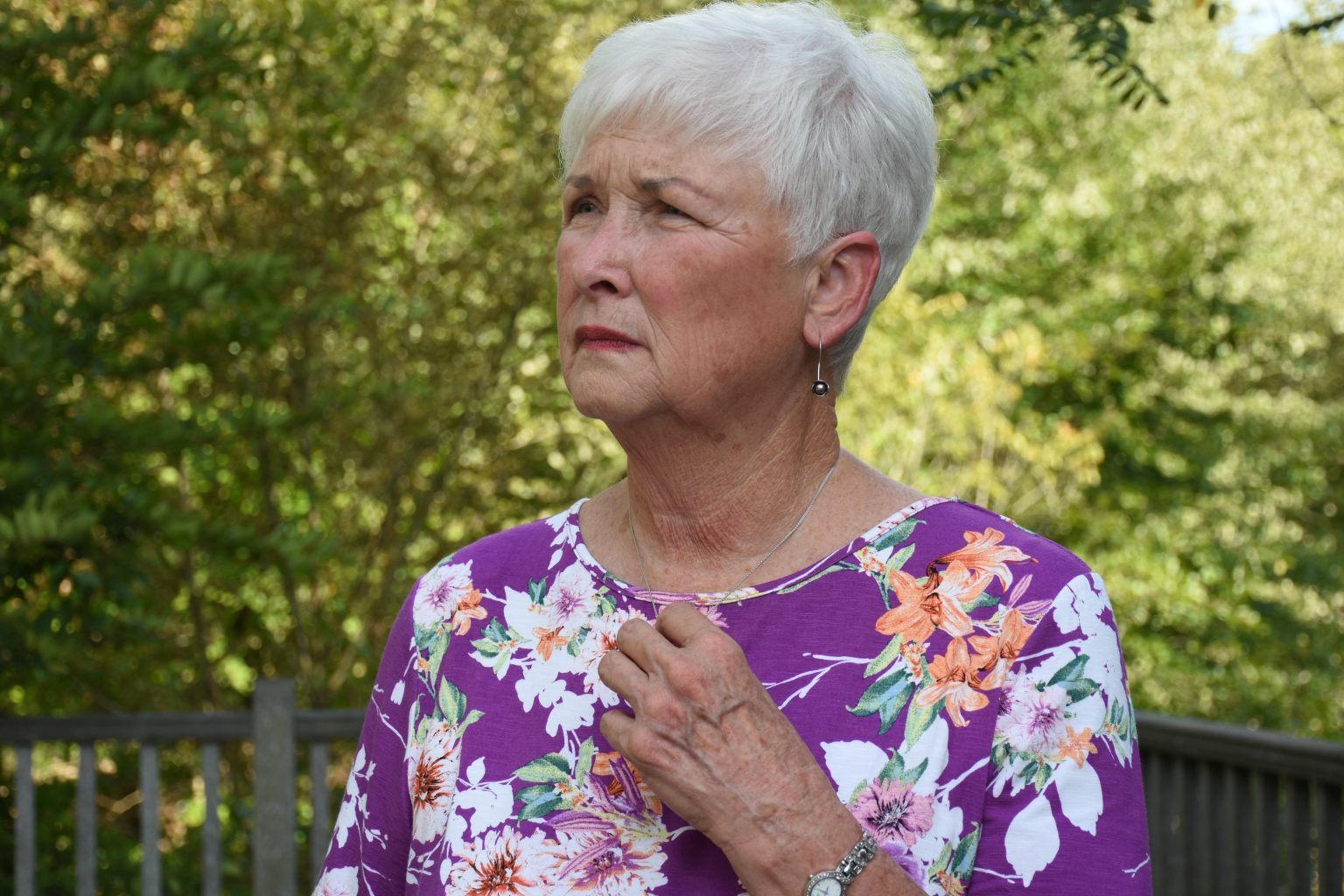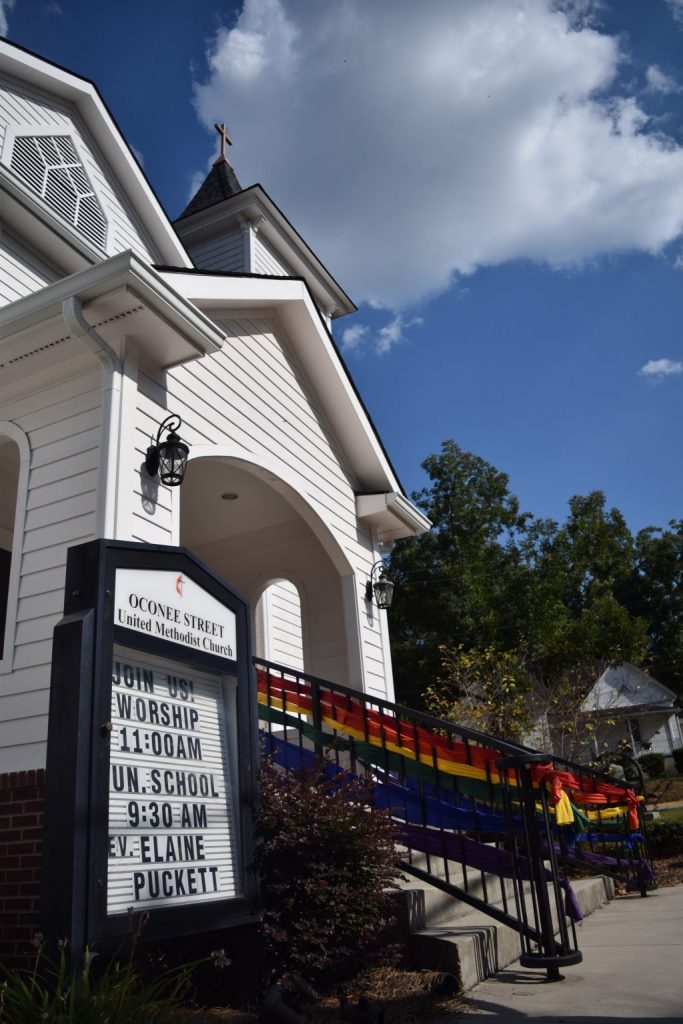Former Clarke Central High School principal Dr. Maxine Pinson Easom (left) sits with community member Patsy Hawkins-Arnold (right) on a bench outside. Pinson Easom and Hawkins-Arnold recently wrote a book on East Athens, it’s culture and it’s history. “One of the things that we did in the book was mix together actual history with things that people told us about that specific thing,” Pinson Easom said.”So we would be looking for history and we would write about history and then we would have (quotes) from our interviews things that people said.” Photo by Krista Shumaker
“Across The River: The People, Places, and Culture of East Athens”, written by Dr. Maxine Pinson Easom and Patsy Hawkins-Arnold, acknowledges the origins of East Athens and the city of Athens as a whole.
For years, there has been a stigma surrounding East Athens originating from the Westside. What seems to be an endless competition in terms of academics, class, progression and growth, has created a division within the community, leaving one to question what makes the Eastside so different from the Westside.
According to former Clarke Central High School principal, Dr. Maxine Pinson Easom, and community member Patsy Hawkins-Arnold, the Athens community was divided into wards in the 19th century, the first ward being East Athens and the second and third ward being the Northwestern and Northeastern parts of Athens.

Former Clarke Central High School principal Maxine Pinson Easom looks off the the side while outside. Pinson Easom recently became interested in the history of Athens, which inspired her to write a book on the topic. “I (have) lived (in Athens) my whole life, but I don’t know history (of) the area,” Pinson Easom said. “From the time I started (reading about it) at the library I was hooked.” Photo by Krista Shumaker
“The governed black districts, voting districts now, used to be called wards. There were three originally, and the first ward is what we defined as East Athens. Honestly it was about half of Athens at that time,” Dr. Pinson Easom said.
The wards formed separation between the community and in response to those changes the people of Athens created competition.
According to Christine Kadri, a former Cedar Shoals High School freshman and is now a CCHS sophomore, there is an on-going rivalry between CCHS and CSHS, both athletically and academically, but the long-lasting debate isn’t necessary.
“A lot of people tend to quickly judge Cedar Shoals like ‘Oh, they’re crowded’. ‘They’re troublemakers’. Which is not the truth,” Kadri said. “The truth is that (CSHS) is no different from (CCHS), sure we’re on a different side of the town but that shouldn’t draw a line between people.”
To District 9 School Board Representative John Knox, some community members have an incomplete understanding of the differences between East and West Athens.
“I just think that there are people that live in (Athens and) their definition of Athens is pretty small,” Knox said. “To some extent, there are definitely people for whom Athens means just right around a very small definition. We’re never going to change things educationally or otherwise if we keep those attitudes”
Although many may presume Athens as a unified and small community there is a big division between the East and West sides. Both sides of Athens have their own remarkable attractions, cultures, and histories.
In 2013, the two women native to the Eastside of Athens, Dr. Pinson Easom and Hawkins-Arnold, united to address the Eastside of Athens through a book that would highlight the history, landmarks and culture of East Athens. Their book, “Across the River: The People, Places, and Culture of East Athens”, includes maps in every chapter, identifying significant places like Carr’s Mill. The book also includes handwritten journal entries, giving context to the lives of many citizens from Athens.
“I grew up on Oak Street and had lived on the Eastside of Athens all my life. Maxine had also lived on the Eastside of Athens all of her life. We met at a local restaurant several years ago, and she said, ‘You know, Patsy? We ought to write a book about our side of Athens.’ And I said, ‘Well, I don’t write, but I can help you do that,’” Hawkins-Arnold said. “We both realized it was an important part of Athens that had not been written about before, so we decided we would give it a try.”
Although the two had lived on the Eastside, they didn’t have much knowledge of the previous events that had occurred on their side of town, revealing the need for comprehensive history to be written.
“(Patsy and I) spent the summer in the (Hargrett Rare Book & Manuscript) Library, which is one of the libraries at the University of Georgia that has rare books and historic documents in it,” Dr. Pinson Easom said. “I wasn’t deliberately disinterested in history, but it wasn’t one of those things that drew me. (Then) I started learning the area, about the history (of) where we are now.”
Fascinated by their discoveries, the pair came to the realization that there was an entire plethora of history about their side of town that hadn’t been recognized.
“There are a number of history books about the westside of town, but nothing is written about what we call the old first ward, or East Athens. East Athens is where Athens started, so there ought to be a recorded history about (it),” Dr. Pinson Easom said.”
“Across the River: The People, Places, and Culture of East Athens” starts off by organizing the historical events and monumental sites.
“The first chapter of the book kind of is an overview of early history that started in the 1700s. So, we talked about some of those things that were important to Athens’ beginning that had a connection to East Athens,” Dr. Pinson Easom said.
The book not only expresses the significance of locations on the eastside, but it also provides information on the people of Athens. According to Dr. Pinson Easom and Hawkins-Arnold, they worked to ensure that people of all races and struggles were represented in the text, in addition to recognizing the accomplishments of the Eastside.
“We certainly didn’t omit the discrimination that we think occurred to people of Athens of all colors,” Dr. Pinson Easom said. “But our emphasis was on the celebration of the contributions that East Athens made.”

Oconee Street United Methodist Church has existed since the 1800s. In 2014, OSUMC under went rebuilding following its destruction due to a fire. “We had been (writing the book) for maybe close to a year, and (OSUMC) was Maxine’s church all her life and there was a tragedy: her church burned,” Hawkins Arnold said. Photo by Luna Reichert
Dr. Pinson Easom and Hawkins-Arnold traveled through their hometown unearthing untold stories of native East Athenians like themselves. According to Hawkins-Arnold, the pair came across journal entries from a variety of people, detailing various aspects of their lives.
“(Dr. Pinson Easom and I) got information from all kinds of people. Everybody that we talked to were very supportive and wanted to share their memories and how their family lived.” Hawkins- Arnold said.“One man in particular (who) shared a lot of his life with us shared with us a copy of a small book that his sister, who was a schoolteacher, had written. It was priceless.”
Although the two women crafted the book, they needed assistance in collecting visuals and designing the cover. They hired local formatter Kenneth Storey, who had also worked on similar books related to the Athens community.
According to Storey, there were a few minor challenges with the production of the book, but he was satisfied with the outcome.
“It was so much material involved (with) images, and we had to keep backing up and checking references and photographs to make sure everything was correct,” Storey said. “Considering all that, I was very happy with the way the book turned out. It’s a very handsome looking book, so I’m very pleased with it.”
The production of the book took six years. In hopes of informing Athenians about the founding of East Athens, Dr. Pinson Easom and Hawkins-Arnold wrote this book not only to recognize the history of Athens but to also encourage embrace the importance of all parts of Athens.
Patsy Arnold and former Clarke Central High School principal Maxine Easom produced their self-published book, Across the River, which uses illustrations and first hand accounts to tell a forgotten history of East Athens.
Story by Tecoya Richardson
Video by Colin Frick
Package by Ireland McCage
